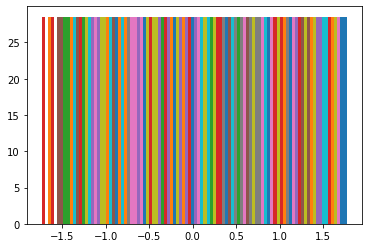随机舍入#
在有限精度算术中,初等算术运算的结果通常不在基础的数字系统 \(F\) 中,因此必须通过称为舍入的过程将其映射回 \(F\)。最常见的选择是四舍五入到最接近的,即选择 \(F\) 中与给定数字最近的数字;这是 IEEE 标准浮点算法中的默认值。
四舍五入是确定的:给定相同的数字,它总是产生相同的结果。
随机舍入 ( [Croci et al., 2022] )将实数 \(x\) 随机映射到有限精度数系统中两个最近的值之一。选择这两个数中的任何一个的概率是 \(1\) 减去它们到 \(x\) 的相对距离。如果用来计算两个长度为 \(n\) 的向量的浮点运算内积,它会产生具有高概率的常数 \(\sqrt{n u}\) 的误差边界,其中 \(u\) 为单元舍入(unit round-off)。对于四舍五入到最近(round to nearest,简写 RN)的情况不一定是这样,因为最坏情况的误差界是常数 \(nu\)。SR 的一个特别吸引人的地方是,与 RN 不同,它不受停滞现象(phenomenon of stagnation)的影响,在这种情况下,相对大量的微小更新序列会丢失。
import numpy as np
from matplotlib import pyplot as plt
import torch
def get_symmetric_range(x):
'''获取对称范围'''
beta = torch.max(x.max(), x.min().abs())
return -beta.item(), beta.item()
def get_affine_range(x):
'''获取仿射范围'''
return x.min().item(), x.max().item()
data = torch.distributions.normal.Normal(0, 0.5).sample((3, 64, 7, 7)).flatten()
boundaries = get_affine_range(data)
a, _, _ = plt.hist(data, density=True, bins=100, histtype='stepfilled')
ymin, ymax = np.quantile(a[a > 0], [0.25, 0.95])
plt.vlines(x=boundaries, ls='--', colors='purple', ymin=ymin, ymax=ymax)
plt.show()

data = torch.distributions.normal.Normal(0, 0.5).sample((1, 10))
data
tensor([[-0.6976, 0.0045, 0.1539, 0.2485, -0.4440, -0.0589, 0.1708, 0.6126,
0.2341, 1.1028]])



